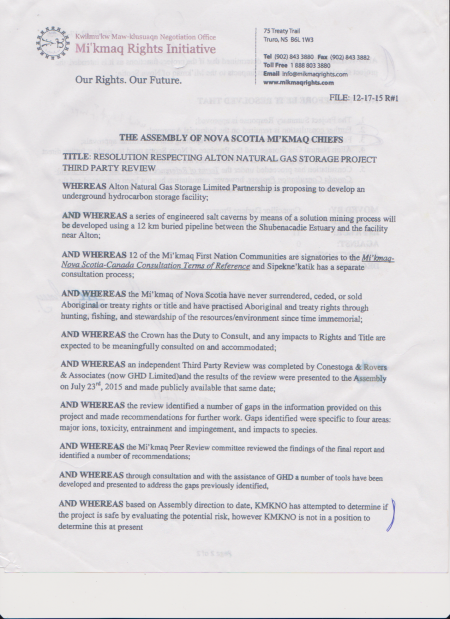When Energy Minister Samson announced that the government was going to grant all the necessary approvals for the Alton Gas Brine Processing and Discharge Facility on the Shubenacadie River, opponents felt that the Mi'kmaq Rights Initiative [KMKNO] had played a key role in 'green lighting' the project.
KMKNO, Kwilmu’kw Maw-klusuaqn Negotiation Office, (often referred to as KMK) is the treaty rights negotiation organization of the Assembly of Mi'kmaq Chiefs. After a constitutionally required aboriginal consultation process with the project proponents and the provincial government, KMK reported to the Assembly on the “technical review” component of the consultations. The Assembly passed a resolution affirming that
"KMK has determined that if the project functions as it is intended, the project should not have significant impacts for the Mi'kmaq of Nova Scotia."
The highlighted part of the resolution is what received so much attention when a few weeks later it became clear to everyone that the government was going ahead with approvals of the project.
Sipekne'katik First Nation had withdrawn from the KMK consultation process some time before, insisting that the provincial government consult directly with them. While remaining within the KMK process, Millbrook First Nation has supported Sipekne'katik and insisted that the government needs to engage directly with the people of their communities.
The ensuing sharp divisions among Mi'kmaq have resulted in Sipekne'katik First Nation withdrawing completely from the Nova Scotia Assembly of Mi'kmaq Chiefs. KMK staffers from Sipekne'katik and Millbrook have faced considerable hostility for their perceived role in the process.
Halifax Medi Coop decided to take a look inside the dynamic of KMK and the Alton Gas project consultations. While the story begins before the provincially required 2007 Environmental Assessment and it's lack of any meaningful consultation, it begins in earnest in the summer of 2014.
Construction of the project brine discharge facility for salt washed from the underground caverns being constructed was essential complete two years ago. Let alone had there been no meaningful Mi'kmaq consultation, it was recently discovered through HMC enquiries that the industrial operation was set to begin without even an application for an Industrial Approval from Nova Scotia Environment.
Mi'kmaq fishers, with the support of allies, began protests about the lack of consultation. Consultation with the Mi'kmaq has always been required, but only lip service was paid to it in the 2007 environmental assessment and subsequent attempts to force the government to pay attention to Mi'kmaq requests.
While consultation had always been required, in 2014 recent Supreme Court decisions had given the “duty to consult” much sharper teeth. So with the Mi'kmaq protests, the MacNeill government decided that it better back up and initiate some aboriginal consultation.
On behalf of the Assembly of Mi'kmaq Chiefs, KMK did make that now controversial determination “that if the project functions as it is intended, the project should not have significant impacts for the Mi'kmaq of Nova Scotia." That finding is best characterised as a work in progress of consultation. The December Resolution of the Assembly summarising the process set out a number of key qualifications with that controversial determination.
KMK staff feel that the provincial government simply walked away from the technical discussions of the consultation and is responsible for misleading the technical process. KMK was left with the impression among Mi'kmaq that it had in practice given the project their blessing- that KMK's witholding of aboriginal consent was only a legalistic formality.
One of the objections in the KMK-developed Assembly resolution about the consultation process to date was pointing out the hazards in government initiated “project splitting”. Like all government required environmental assessments, the 2007 EA was only the beginning of a larger and more in depth regulatory oversight process standard for industrial projects.
The operation of the gas storage caverns thenselves are regulated by the Utility and Review Board, which gave it's construction and operation approval for a projected 18 salt caverns in 2013. Nova Scotia Environment chose not to engage in any ongoing regulation and oversight, even though the UARB process and mandate includes no review of environmental and human health effects of projects.
Perhaps that omission is consistent with and part of the noted HMC discovery of the lack in 2014 of any regulation and oversight before the 2012 Mi'kmaq protests, even though the brine discharge facility was due to begin operation. Those protests led to the consultation process handled by KMK for the Assembly of Mi'kmaq Chiefs.
To date there has been exactly zero consultation with Mi'kmaq people over the salt caverns “aspect” of the Alton Gas project.




